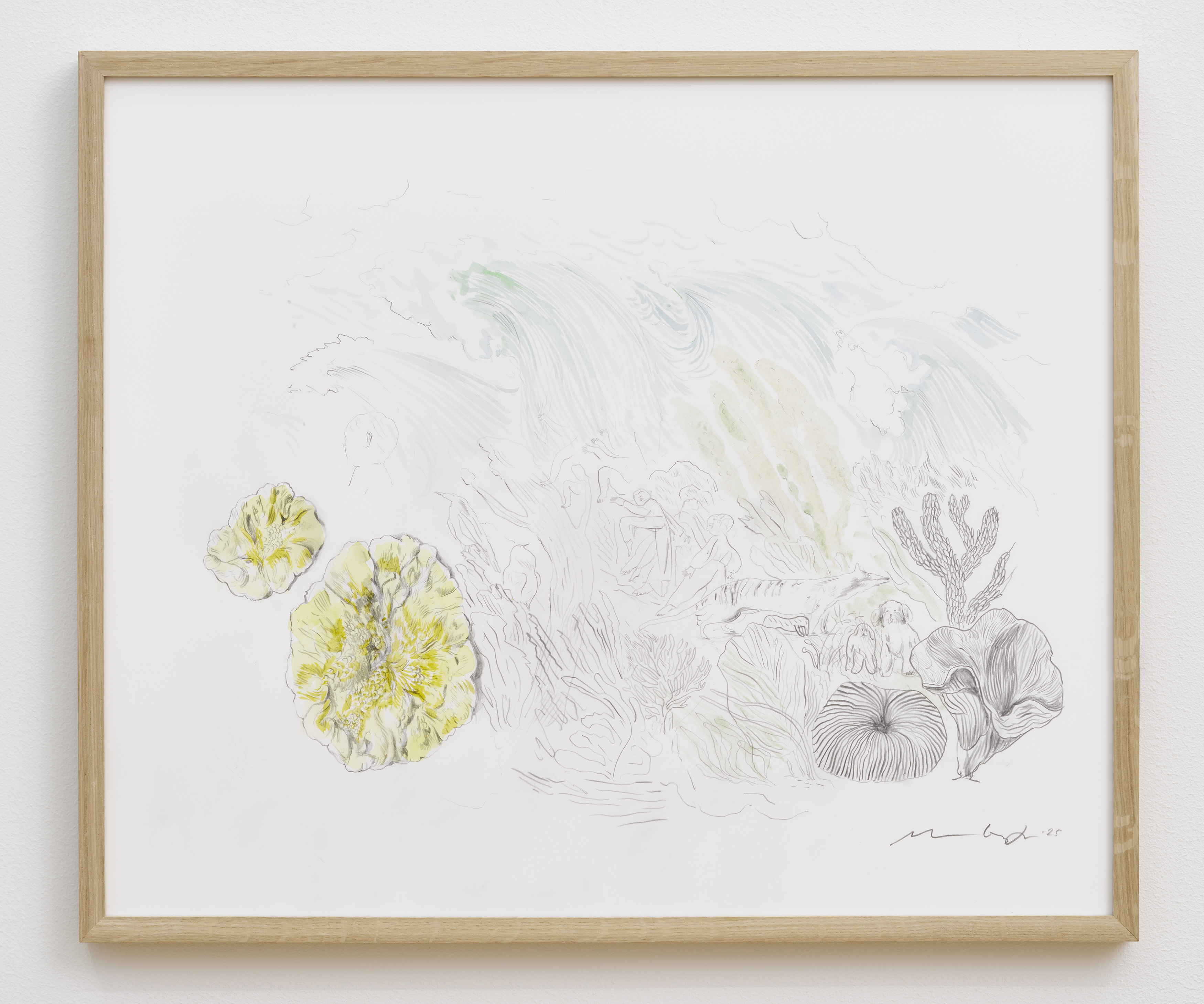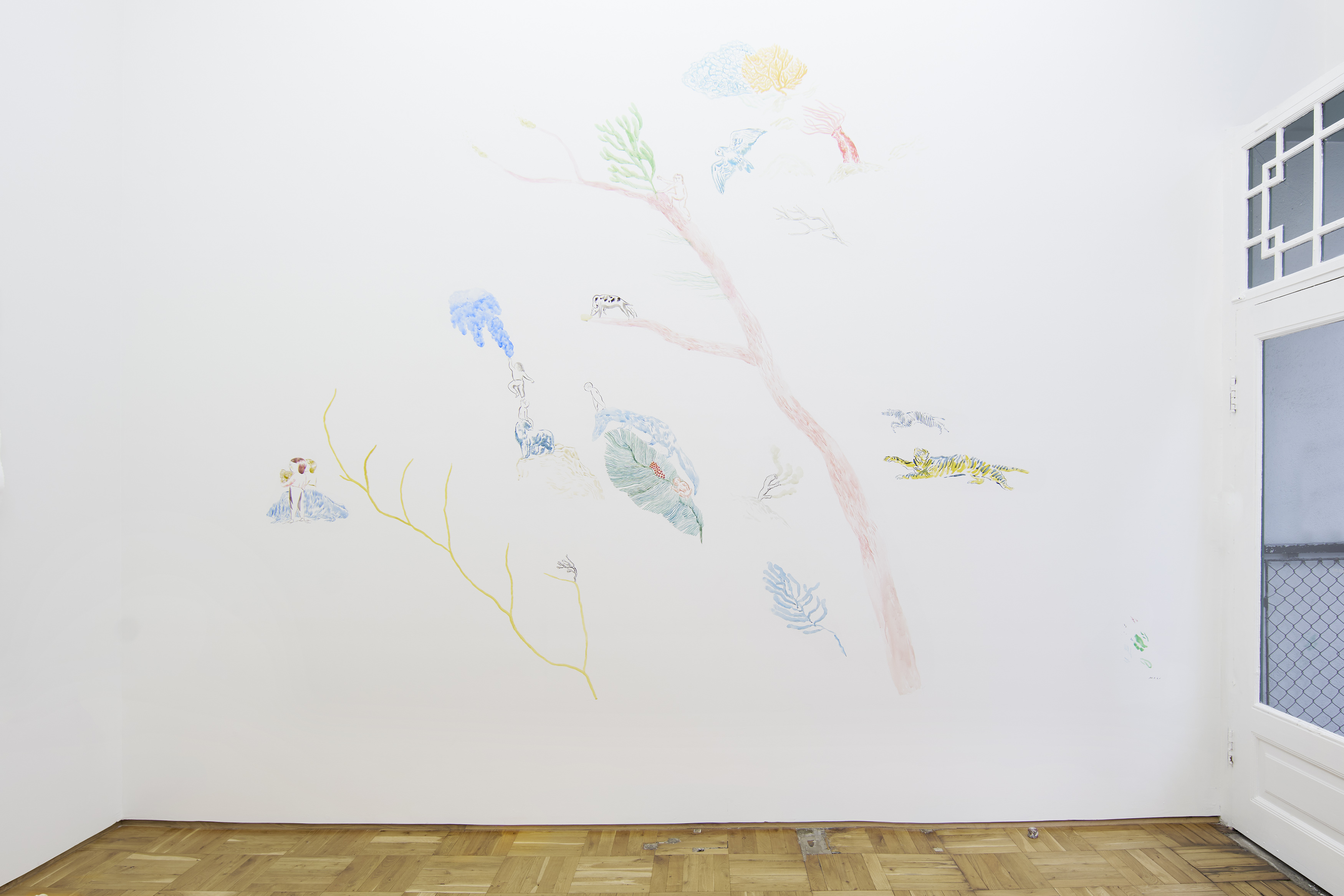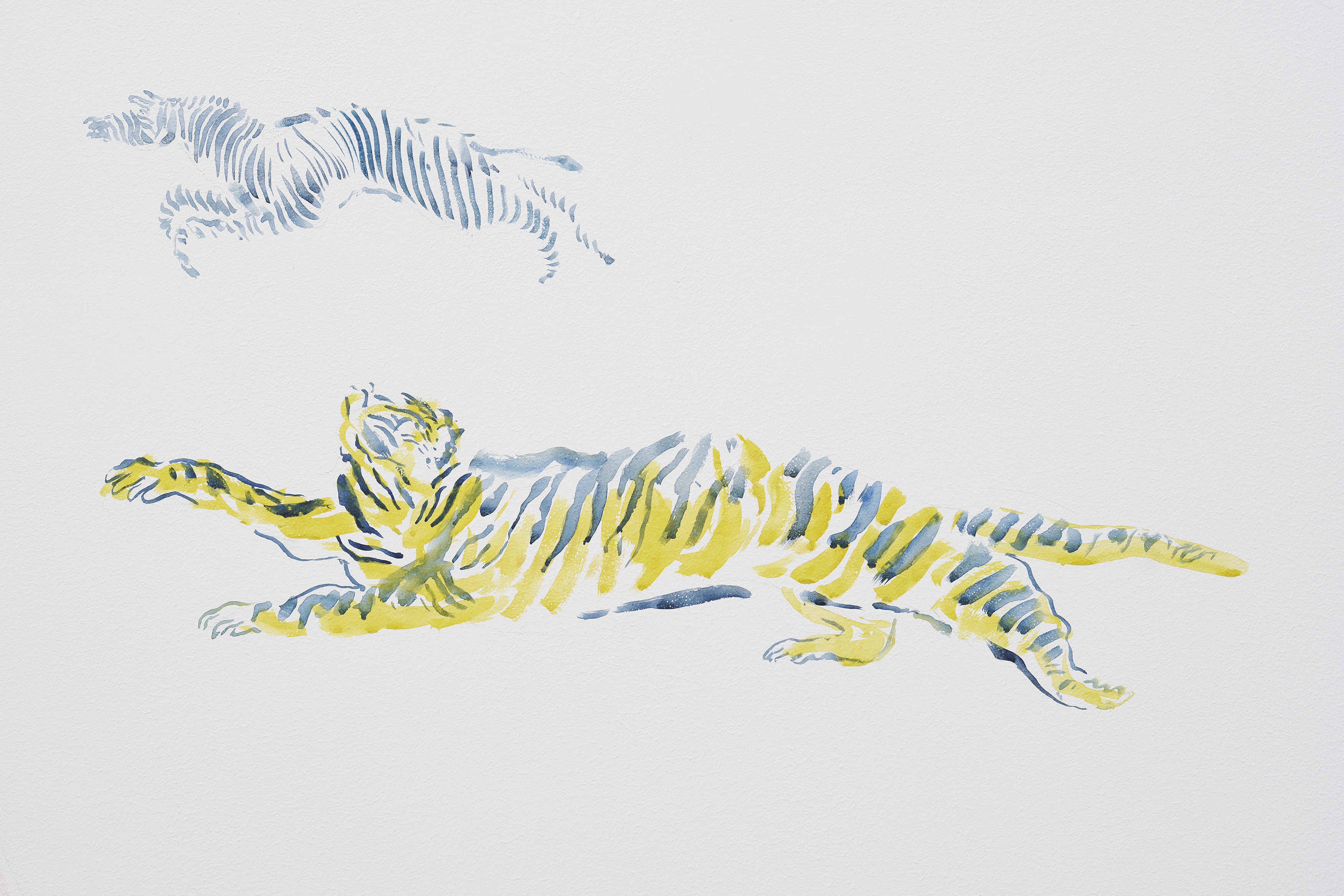November 21, 2025 - January 18, 2026
Mari Kanstad Johnsen
Inn til mosen
Opening Reception: Friday, November 21, 18:00–21:00
Entrée, Markeveien 4b, Bergen
 Mari Kanstad Johnsen, Inn til mosen, exterior view at Entrée. All photos by Øystein Klakegg.
Mari Kanstad Johnsen, Inn til mosen, exterior view at Entrée. All photos by Øystein Klakegg. Press
05.12.2025
Kunstkritikk
Larven i øyehøyde
av Kristoffer Jul-Larsen
Entrée er stolte av å presentere separatutstillinga Inn til mosen av Mari Kanstad Johnsen. I utstillinga inviterast vi inn i hennar visuelle verd – ein stad mellom det barnlege og vaksne, mellom røynd og draum. Her er mosen ikkje berre eit motiv, men eit taktilt landskap der alt levande heng saman, og pustar i same rytme.
I arbeida på Entrée leikar Kanstad Johnsen med proporsjonar, forstørrar det mikroskopiske og sidestiller det med velkjende vesen. Det kan opplevast som undervasslandskap der fortid, notid og framtid flyt saman i kvarandre. Ei av inspirasjonskjeldene er Chauvet-grotta i Sør-Frankrike, som huser dei eldste kjende hulemåleria.
Gjennom blyantteikningar og akvarellar, veggmaleri og keramiske figurar let ho improvisasjon og teikneflyt forme detaljrike univers der ein kan dykke inn – og gå seg vill. Arbeida hennar viser organiske komposisjonar som tematiserer tap av natur og tap av tilhøyrsle, både for dyr og menneske.
Snarare enn å skape ein dyster visjon av kvar verda vår er på veg, søker Kanstad Johnsen å forme meditative tablå som opnar for eigne refleksjonar over moglege framtider – og over korleis vi, verda og naturen heng uløyseleg saman. No, før og framover.
Mari Kanstad Johnsen (f. 1981, Bergen) bur i Oslo og arbeider som biletkunstnar, frilansillustratør og forfattar. Hennar uttrykk er fullt av barnleg livslyst, med underlege dyr og menneske. Ho er utdanna ved Kunsthøgskolen i Oslo og Konstfack i Stockholm. Ho har illustrert fleire bøker, skrive bøker for barn og hatt oppdrag for mellom anna Morgenbladet, The New York Times, Kunstløftet og Nasjonalmuseet, samt utført temporære veggmaleri ved Deichman bibliotek og Nasjonalmuseet, og permanente verk ved Nordnes skole, Tøyen skole og Høgskulen på Vestlandet.
Ho har hatt fleire utstillingar i inn- og utland og motteke ei rekke prisar for arbeidet sitt. I 2022 vart Dyrene sover (Bedtime for Bo) (med tekst av Kjersti Annesdatter Skomsvold, Aschehoug 2021) kåra til ei av årets ti best illustrerte barnebøker av The New York Times, og til Årets vakreste bok i konkurransen Årets vakreste bøker i Noreg.
![]()
Mari Kanstad Johnsen, Inn til mosen, exbibition view at Entrée.
Entrée is proud to present the solo exhibition Inn til mosen (Into the Moss) by Mari Kanstad Johnsen. In this exhibition, we are invited into her visual world – a place between childhood and adulthood, between reality and dream. Here, the moss is not merely a theme, but a tactile landscape where all living things are connected, and everything breathes with the same rhythm.
In her works at Entrée, Kanstad Johnsen plays with proportions, magnifying the microscopic and juxtaposing it with familiar creatures. It can be experienced as an underwater landscape where past, present, and future flow together. One of her sources of inspiration is the Chauvet Cave in southern France, home to the oldest known cave paintings.
Through pencil drawings and watercolours, wall paintings and ceramic figures, she lets improvisation and the flow of drawing shape intricate universes that one can dive into – and lose oneself within. The works consists of organic compositions that address the loss of nature and belonging, both for animals and humans.
Rather than creating a dark vision of where our world is headed, Kanstad Johnsen seeks to form meditative tableaux that open up for personal reflection on possible futures – and on how we, the world, and nature are inextricably connected. Now, before, and onwards.
Mari Kanstad Johnsen (b. 1981, Bergen) lives in Oslo and works as a visual artist, freelance illustrator, and author. Her expression is full of childlike vitality, featuring strange animals and people. She was educated at the Oslo National Academy of the Arts and Konstfack University College of Arts, Crafts and Design in Stockholm. She has illustrated several books, written children’s books, and completed commissions for, among others, Morgenbladet, The New York Times, Kunstløftet, and the National Museum. She has also created temporary wall paintings at Deichman Library and the National Museum, and permanent works at Nordnes School, Tøyen School, and Western Norway University of Applied Sciences.
She has exhibited widely in Norway and abroad and has received numerous awards for her work. In 2022, Dyrene sover (Bedtime for Bo) (with text by Kjersti Annesdatter Skomsvold, Aschehoug 2021) was named one of The New York Times’ten best illustrated children’s books of the year and was awarded The Most Beautiful Book of the Year in Norway’s Most Beautiful Books competition.
 Mari Kanstad Johnsen, Inn til mosen 1-6 , (2025). Pencil, watercolor and ink on paper, oak frame and museum glass, 52 x 62 cm
Mari Kanstad Johnsen, Inn til mosen 1-6 , (2025). Pencil, watercolor and ink on paper, oak frame and museum glass, 52 x 62 cm
 Mari Kanstad Johnsen, Inn til mosen 1, (2025). Pencil and watercolor on paper, oak frame and museum glass, 52 x 62 cm
Mari Kanstad Johnsen, Inn til mosen 1, (2025). Pencil and watercolor on paper, oak frame and museum glass, 52 x 62 cm
Mari Kanstad Johnsen, Inn til mosen 2, (2025). Pencil and watercolor on paper, oak frame and museum glass, 52 x 62 cm

Mari Kanstad Johnsen, Inn til mosen 3, (2025).Pencil on paper, oak frame and museum glass, 52 x 62 cm

Mari Kanstad Johnsen, Inn til mosen 4, (2025). Pencil and ink on paper, oak frame and museum glass, 52 x 62 cm

Mari Kanstad Johnsen, Inn til mosen 2, (2025). Pencil and watercolor on paper, oak frame and museum glass, 52 x 62 cm

Mari Kanstad Johnsen, Inn til mosen 2, (2025). Pencil and watercolor on paper, oak frame and museum glass, 52 x 62 cm
 Mari Kanstad Johnsen, Inn til mosen, exbibition view at Entrée.
Mari Kanstad Johnsen, Inn til mosen, exbibition view at Entrée.
 Mari Kanstad Johnsen, Rester, (2025). Ceramic figures, glazed stoneware with colored underglaze, variable dimensions.
Mari Kanstad Johnsen, Rester, (2025). Ceramic figures, glazed stoneware with colored underglaze, variable dimensions.

Mari Kanstad Johnsen, Rester, (2025). Ceramic figures, glazed stoneware with colored underglaze, detail.

 Mari Kanstad Johnsen, Fotfeste, (2025). Watercolor on wall.
Mari Kanstad Johnsen, Fotfeste, (2025). Watercolor on wall.

Mari Kanstad Johnsen, Fotfeste, (2025). Watercolor on wall, detail.

 Mari Kanstad Johnsen, Inn til mosen 7, (2025). Pencil and watercolor on paper, without frame. 57 x 76 cm
Mari Kanstad Johnsen, Inn til mosen 7, (2025). Pencil and watercolor on paper, without frame. 57 x 76 cm

 Mari Kanstad Johnsen, Inn til mosen, exterior view at Entrée.
Mari Kanstad Johnsen, Inn til mosen, exterior view at Entrée.


